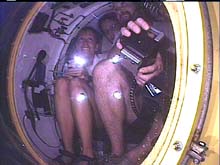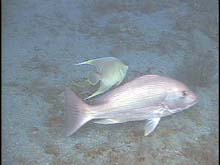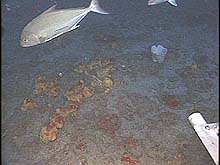
A greater amberjack swims past archeri sponges on the ocean floor. These sponges have never been seen this far north. There is also a white campana sponge, or vase sponge (left). Click image for larger view.
A Comparison of Gray's Reef and Savannah Scarp
September 10, 2001
Reed Bohne, Manager
Gray's Reef National Marine Sanctuary
NOAA
Dr. Jack McGovern
Associate Marine Scientist
South Carolina Department of Natural Resources
![]() View a video of one of the sea's most fascinating creatures, the octopus. (5.6 MB, QuickTime
View a video of one of the sea's most fascinating creatures, the octopus. (5.6 MB, QuickTime ![]() required).
required).
For those of us from the Gray's Reef National Marine Sanctuary, the exploration of the Savannah Scarp is a trip to a realm closely related to, but significantly different from, the familiar waters of the sanctuary. At the surface, the endless expanse of water with Sargassum weed drifting by is familiar, but at this depth and proximity to the Gulf Stream, the water is a deep cobalt blue. At Gray's Reef, 40 mi shoreward, the water over the reef 60 ft below is often a jade green, rich in nutrients and influenced substantially by sediments washing off the coastal plain in Georgia and out the rivers and estuaries along the shore. At the Scarp we are riding the edge of the Gulf Stream, with its clear, tropical water, which is less rich in nutrients, but carries the tropical species that spin out in eddies and populate Gray's Reef with its more hardy and temperature-tolerant individuals.
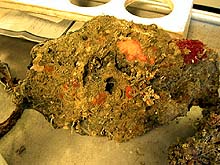
This rock was collected as a sample from the Savannah Scarp. Click image for larger view.
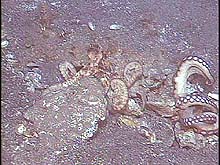
These two octopi are well camouflaged among the rocks and sediment. Click image for larger view.
A Look at the Bottom of Savannah Scarp
Descending 200 ft to the sea floor, the ambient light levels remain strong. Visibility is about 30 ft, but we notice that we can see features in the distance best if we leave the sub lights off. The scarp presents a very different vista from the one at the sanctuary. At Gray's Reef, extensive sand flats are interrupted by large, rocky ledges and diffuse patches of live bottom habitat. Our view at the scarp reveals broad boulevards of broken, rocky rubble, sloping gradually, from 190 to 225 ft, into open sandscapes. Of course, we have but a snapshot of this environment, which may not be fully representative of the diversity of habitat here, but is clearly different from the topography at Gray's Reef.
At the scarp, we know the rock formations are considerably older than those closer to shore. As the continental shelf gradually slopes downward offshore, the rocks that emerge represent earlier geologic eras. While we must await the detailed geologic analysis of the rock samples to characterize them properly, these rocks appear darker and more porous than formations at Gray's Reef. The analysis will also reveal whether these rocks were part of an ancient shoreline.
The physical environment governs which species will be successful in colonizing the hard substrate of the scarp and Gray's Reef. The rock environment of the scarp, unlike Gray's Reef, is sparsely populated with sponges, tunicates, mossy bryozoans, and cnidarians. The rock at the scarp appears to be considerably more barren. Not surprisingly, the scarp holds more tropical invertebrate species than we find at Gray's Reef. Greg McFall, the sanctuary research coordinator, recovered species of tube and finger sponges that are familiar in Florida but rare in the near-shore waters of Georgia.
The Scarp is well-known as a haven for snappers, groupers, and porgies of commercial and recreational importance. During our dive, we encountered many groupers, such as gag and scamp. Large numbers of red snapper, vermilion snapper, some red porgy, and knobbed porgy occurred during transects across the bottom. Greater amberjack followed the submersible and seemed to swarm around it whenever it stopped. We also saw many small, colorful species, such as tattler, blue angelfish, several species of butterflyfish, cardinalfish, wrasses, and damselfish. Many of these species, as adults, are found less frequently at Gray's Reef, but reside at the sanctuary during larval or juvenile stages of their life histories. Our most obvious reef fish at the sanctuary, the black sea bass, is absent at the scarp. Dr. George Sedberry, chief scientist on this cruise, reports that long-term trapping data indicate that black sea bass are rarely found in waters deeper than 150 ft.
Harvey Walsh, of NOAA's Beaufort Lab, is using a small beam trawl to capture early life stages of fishes at the scarp, and he will compare his finds with what he has discovered at the sanctuary. Through his work for the sanctuary, we will have a good characterization of the early life histories of these fish species across the continental shelf off Georgia. Furthermore, video footage obtained during submersible dives at the scarp will be compared to video obtained at Gray's Reef to describe differences and similarities in the composition and abundance of invertebrate and vertebrate species.
A Valuable Field Experience
Jill Jennings
University of Charleston, CCHEBR/NCCOS/NOS
Graduate Student, Submersible Observer
This was one of the most spectacular expeditions in which a young scientist could participate. The geology and ecology of the area are so interesting, and one learns so much more by experiencing it firsthand. I also learned a great deal from the day-to-day interactions with the media by observing how science and the media can work together toward the same educational goals.
On our way out to the Savannah Scarp (~70 mi offshore), we saw a waterspout far off in the distance, which was a spectacular sight. We then came upon a large pod of pilot whales that rode along the bow of our ship for quite a while. They appeared to be as interested in us as we were in them. At certain times, you could even hear them making noises with one another on the surface. We also saw a pod of spotted dolphin on the second day.
Once we reached our destination, we began to prepare for the first submersible launching. It was an amazing sight to see the Clelia lifted above the stern of the ship, and dangle in the air before being launched into the water. Once the Clelia was at the bottom, the sub pilot was able to communicate with the surface, where the crew navigates the sub in the direction of the target areas.
I participated in a dive on Saturday to an area known as "The Sampler," where we descended to a maximum depth of 250 ft. The experience was amazing, especially when we first plunged into the water. It was similar to scuba diving, but without having to worry about buoyancy control or breathing through a regulator. Once we reached the bottom and allowed the sediment to settle, the visibility outside of our observation window was about 30 ft. The sediment was fine, but too compact to allow us to take a sediment core sample.
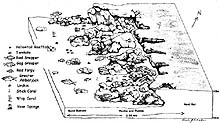
Schematic representation of the shelf-edge reef community at Savannah Scarp. Click image for larger view.
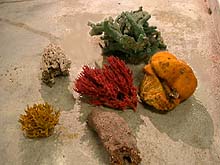
A variety of sponges from Savannah Scarp. Click image for larger view.
Chris Koenig and Sandra Brooke, scientist observers in the Clelia, reported that the habitat looked reasonably good in this location with no signs of bottom-trawling activities. They reported seeing "tons" of amberjack.
While some ocean scientists may argue that manned submersibles will one day be replaced by ROVs or even by autonomously operated vehicles (vehicles without tethers) that can be programmed to navigate by an on-board computer, many others would argue that there is a role for the human observer and that manned submersibles are here to stay. Judging from the interest of the scientists aboard this expedition, everyone wants to get beneath the surface to have a look for themselves, whether exploring through a video screen linked to an ROV or peering through the porthole of a submarine.
Compared to the other dives on this leg of the expedition, we saw relatively little relief, and no schools of large pelagic fish, such as greater amberjack. When we came upon some relief, however, it was only a few inches high and was surrounded by life. Each rock we encountered seemed to be occupied by either a juvenile snowy grouper or short bigeye, and oftentimes one of each. We also saw many tattler, yellowtail reeffish, butterflyfish, scamp, gag, and a large red snapper. We saw many vermilion snapper schooling just outside of our lights.
At one point, we turned off all of the external lights, and used sonar to locate areas of reef. Unfortunately, we were unsuccessful. Just prior to our ascent, we came upon a rocky area surrounded by shell hatch and inhabited by two octopii (see photo in log, above). It was interesting to observe them as they interacted with the suction tube that the submersible pilot positioned nearby.
During the nights, I helped with the deployment of beam trawls and the sorting of catches. This was an interesting supplement to the information we were obtaining from the videos taken during the submersible dives. The goal of this part of the study was to observe the diversity and abundance of organisms, primarily fish and shrimp, that used areas outside of Gray’s Reef, just inshore of the shelf-edge (~120 ft), as a nursery ground. We collected many interesting specimens, including rock shrimp, a seahorse, many octopii, juvenile moray eels, juvenile filefish, juvenile puffers, and various species of grouper and sea bass. The trawls were conducted on the bottom and brought with them many pen shells, Oculina fragments, and shell hatch.
The knowledge I gained on this research cruise has been extremely valuable in bringing a greater field component into my master's thesis work. I analyzed approximately 30 yrs of fisheries-independent data from a database, called MARMAP, in the continental shelf and upper slope of the southeastern Atlantic coast for trends in abundance, biomass, and diversity. One of my primary observations from this expedition is that it brought some more evidence to the result I found, from the historical trawl data, of the highest fish diversity occurring in depths from 40-80 m (120-240 ft). The high diversity and the presence of many tropical fish fauna in this area of the shelf edge are a result of the proximity to the warm, stable waters of the Gulf Stream.
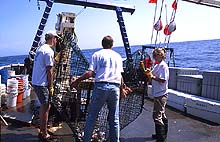
Hauling in a fish trap aboard the R/V Palmetto to study reef fish distribution. Click image for larger view.
A View of the Savannah Scarp from the R/V Palmetto
September 10, 2001
Paulette Powers
Chief Scientist, R/V Palmetto
South Carolina Department of Natural Resources
During this Savannah Scarp leg of the Islands in the Stream-South Atlantic Bight mission, the R/V Palmetto was also on station. The Palmetto conducts annual fishery surveys of reef fishes from North Carolina to Florida. Savannah Scarp is not one of its frequent sampling locations, so this project provided an opportunity to learn more about this important fishery habitat. The collected data will be incorporated into a long-term regional database compiled by the South Carolina Department of Natural Resources on reef fish distribution and relative abundance throughout the region.
Aboard the Palmetto, we made observations of fishes and fish habitats using an ROV (remotely operated vehicle). Six deployments were made with the ROV in two areas of the Savannah Scarp: Sow Pen Reef and Sandwich Reef. All six deployments observed hard, rocky bottom. The bottom was predominantly flat hard bottom except for scattered rocky outcrops that were still low compared to the rocky outcrops normally associated with the southeastern shelf-edge reef.
Most of the usual reef fishes associated with the southeastern coast were abundant here. Among these are several species of groupers: gag, scamp, speckled hind, and juvenile snowy grouper. Red snapper, vermilion snapper, gray triggerfish, soapfish, porcupinefish, tattler, queen and blue angelfish, cubbyu, and black sea bass were all observed with the ROV. Black sea bass and vermilion snapper were two economcially valuable species that were not observed from the submersible dives conducted on these sites during the same time period. Perhaps the most intriguing aspect of this area were the holes or small burrows scattered throughout the area that were heavily guarded by bigeyes (glasseye snappers). These looked similar to deep potholes in pavement, and were a haven for eels and cardinal fish in addition to the bigeyes.
Plenty of the smaller, colorful reef fishes also make this hard, sparse, and not-so-tropical reef their home. Among these are the butterflyfishes (bank, spotfin, and reef), damsels, wrasses, beaugregories, yellowtail reeffish, and two-spot cardinal fishes.
The R/V Palmetto also deployed chevron fish traps to compare the catches with that observed with the ROV. We intended to tag these fishes, release them, and then observe them with the ROV and submersible Clelia. The depth (200-230 ft), however, was simply too great to expect much survival of the tagged fish. We also wanted to observe the fish traps at work, but conditions at sea made it impossible to anchor close enough to the trap to be able to observe with the ROV. The catches in the traps were similar to those we observed with the ROV. Scamp, juvenile snowy grouper, porgies, and black sea bass were all part of the catch, with vermilion snappers being predominant. The abundance of vermilion snapper was particularly interesting, as they were not observed by the submersible Clelia, which conducted dives in the same area. Clearly, a variety of methods are needed to assess reef fish populations on deep reefs such as the Savannah Scarp.
Sign up for the Ocean Explorer E-mail Update List.












































